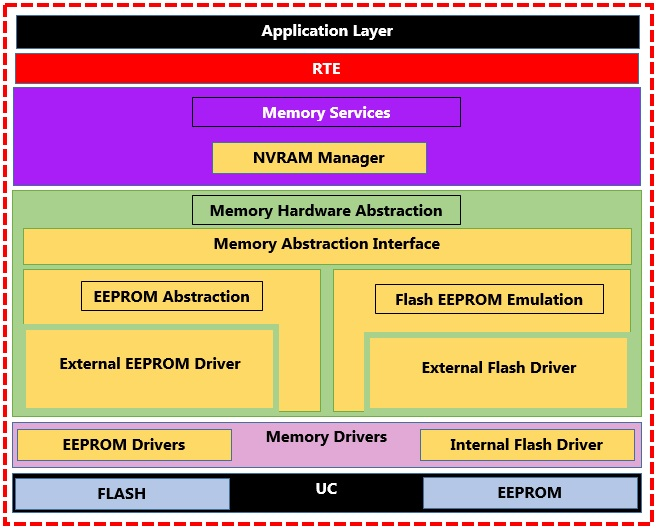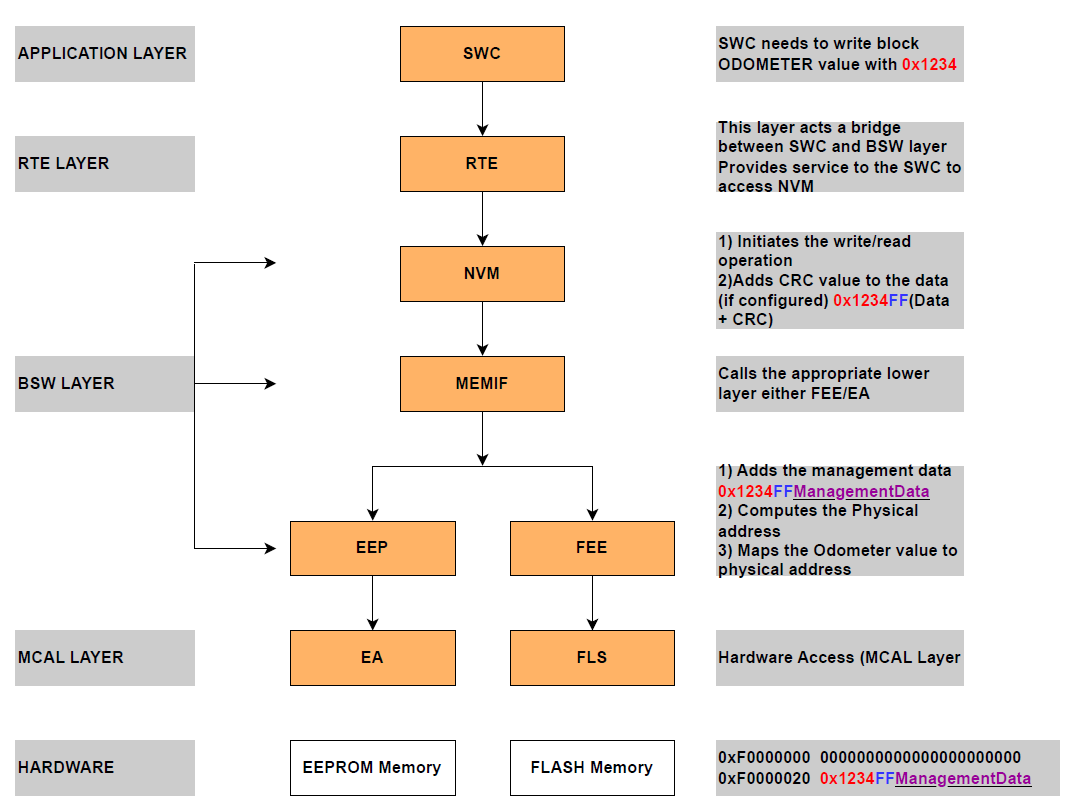The AUTOSAR (AUTomotive Open System ARchitecture) development partnership has revolutionized the automotive industry by providing a standardized framework for developing software applications. One crucial aspect of AUTOSAR is the Memory Stack (MemStack), which enables efficient management of non-volatile memory in automotive systems. In this comprehensive guide, we will delve into the intricacies of the AUTOSAR Memory Stack, exploring its architecture, modules, and functionalities.
Table of Contents
- Introduction to AUTOSAR Memory Stack
- The architecture of the AUTOSAR Memory Stack
- NVRAM Manager (NvM): Ensuring Data Storage and Maintenance
- Memory Abstraction Interface (MemIf): Bridging the Gap
- Flash EEPROM Emulation (FEE): Abstracting a Device-Specific Addressing Scheme
- EEPROM Abstraction (Ea): Ensuring a Uniform Addressing Scheme
- Flash Driver (Fls): Initializing and Accessing Flash Memory
- EEPROM Driver (Eep): Efficient Access to EEPROM Memory
- Use Cases and Applications of the AUTOSAR Memory Stack
- Example of an AUTOSAR Memory Stack
1. Introduction to AUTOSAR Memory Stack
The AUTOSAR Memory Stack, or MemStack, is crucial in managing non-volatile memory in the AUTOSAR framework. It provides services to the application layer and Basic Software Modules (BSW) for accessing non-volatile memory, such as reading from and writing to NV memory. The MemStack ensures that data is stored in a structured manner and can be accessed efficiently. It also abstracts the underlying NV memory devices, enabling seamless integration with different hardware configurations.
2. Architecture of AUTOSAR Memory Stack
The architecture of the AUTOSAR Memory Stack comprises several key modules that work together to facilitate efficient memory management. These modules include the NVRAM Manager (NvM), Memory Interface (MemIf), Memory Abstraction (Flash EEPROM Emulation and EEPROM Abstraction), and Memory Driver Modules (Flash Driver and EEPROM Driver).
The NVRAM Manager is responsible for data storage and maintenance, ensuring that data is stored according to automotive requirements. It handles requests from software components (SWCs) and Basic Software Modules (BSW) to read and write data from and to NV memory. The NVRAM Manager is the gateway for SWCs to access NV memory.
The Memory Interface (MemIf) provides an abstraction layer between the NVRAM Manager and the underlying memory abstraction modules (Flash EEPROM Emulation and EEPROM Abstraction). It creates a virtual segmentation and a linear address space, ensuring that the NVRAM Manager remains independent of the underlying memory device interfaces.
The Memory Abstraction modules, namely Flash EEPROM Emulation (FEE) and EEPROM Abstraction (Ea), abstract the device-specific addressing scheme and provide a virtual addressing scheme. They ensure a uniform addressing scheme, allowing the upper layer modules to remain unchanged even if the underlying memory devices are replaced.
The Memory Driver Modules, including the Flash Driver (Fls) and EEPROM Driver (Eep), facilitate communication with the microcontroller’s memory. These drivers provide reading, writing, and erasing capabilities for the Flash and EEPROM memories, respectively.

3. NVRAM Manager (NvM): Ensuring Data Storage and Maintenance
The NVRAM Manager, also known as the NvM module, is a crucial component of the AUTOSAR Memory Stack. It provides services for data storage and maintenance in NV memory. The NvM module manages the NV data of EEPROM and/or Flash EEPROM emulation devices. It ensures that data is stored and accessed according to individual requirements in the automotive environment.
One of the key functionalities of NVRAM Manager is managing the endurance of NV memory. NV memory has a limited number of writing cycles, and the NvM module ensures that these cycles are managed efficiently to maximize the lifespan of the memory. It also handles error correction and detection mechanisms for NV memory, ensuring data integrity.
The NVRAM Manager is responsible for initializing the memory, performing error handling, and providing services for synchronous and asynchronous read and write operations. It abstracts the underlying memory devices, providing a unified interface for accessing NV memory.
4. Memory Abstraction Interface (MemIf): Bridging the Gap
The Memory Abstraction Interface, or MemIf, acts as a bridge between the NVRAM Manager and the memory abstraction modules (Flash EEPROM Emulation and EEPROM Abstraction). It provides an abstraction layer, ensuring the NVRAM Manager remains independent of the underlying memory device interfaces.
The MemIf module uniformizes access to different memory abstraction modules, creating a virtual segmentation and a linear, uniform address space for the NVRAM Manager. It abstracts the device-specific addressing schemes of Flash EEPROM Emulation and EEPROM Abstraction, providing a unified interface for the upper layer modules.
By utilizing the services of MemIf, the NVRAM Manager can access different memory abstraction modules without needing to know the specifics of each module. This abstraction layer simplifies the memory management process and allows for the seamless integration of different memory devices.
5. Flash EEPROM Emulation (FEE): Abstracting a Device-Specific Addressing Scheme
The Flash EEPROM Emulation (FEE) module in the AUTOSAR Memory Stack abstracts the device-specific addressing scheme and segmentation of Flash memory. It provides upper-layer modules, such as the NVRAM Manager, with a virtual addressing scheme and segmentation.
FEE ensures that the upper layers of the AUTOSAR stack have a virtual addressing scheme that is independent of the physical memory layout. It also provides a virtually unlimited number of erase cycles, enhancing the durability and longevity of the Flash memory.
The FEE module abstracts the complexities of Flash memory and provides a unified interface for reading and writing data. It enables efficient access to Flash memory, ensuring that data can be stored and retrieved seamlessly.
6. EEPROM Abstraction (Ea): Ensuring a Uniform Addressing Scheme
The EEPROM Abstraction (Ea) module in the AUTOSAR Memory Stack provides services for reading, writing, erasing, and comparing data to and from an EEPROM. It abstracts the addressing scheme of the underlying EEPROM driver, ensuring a uniform addressing scheme.
By abstracting the EEPROM driver’s addressing scheme, the EA module allows for easy replacement of the underlying EEPROM device without requiring changes to the upper layer modules. This flexibility enables the NVRAM Manager and other modules to remain unchanged, even if the EEPROM device is replaced.
The Ea module facilitates efficient access to EEPROM memory by providing a unified interface. It ensures that data can be reliably stored and retrieved from EEPROM, enabling seamless integration within the AUTOSAR framework.
7. Flash Driver (Fls): Initializing and Accessing Flash Memory
The Flash Driver, or Fls, is a crucial component of the AUTOSAR Memory Stack responsible for initializing and accessing Flash memory. It provides services for reading from and writing to Flash memory, enabling efficient data storage and retrieval.
The Fls driver initializes the Flash memory and handles the low-level operations required for accessing the memory. It provides functions for reading, writing, and erasing data blocks in Flash memory.
By utilizing the services of the Fls driver, the upper layer modules, such as the NVRAM Manager, can efficiently access the Flash memory. The Fls driver abstracts the complexities of Flash memory, ensuring that data can be reliably stored and retrieved.
8. EEPROM Driver (Eep): Efficient Access to EEPROM Memory
The EEPROM Driver, or Eep, is a vital component of the AUTOSAR Memory Stack responsible for efficient access to EEPROM memory. It provides services for reading, writing, erasing, and comparing data to and from an EEPROM.
The Eep driver abstracts the complexities of the underlying EEPROM device and provides a unified interface for accessing the EEPROM memory. It ensures that data can be reliably stored and retrieved from the EEPROM, facilitating seamless integration within the AUTOSAR framework.
The Eep driver also provides a service for comparing a data block in the EEPROM with a data block in the memory, such as RAM. This functionality is crucial for verifying the integrity of data stored in EEPROM.
9. Use Cases and Applications of the AUTOSAR Memory Stack
The AUTOSAR Memory Stack is utilized in various use cases and applications within the automotive industry. It plays a crucial role in managing non-volatile memory and enabling persistent data storage.
One significant use case of the AUTOSAR Memory Stack is in the management of freeze frame data and event memory in the Diagnostic Event Manager (DEM) module. The NVRAM Manager and the underlying memory abstraction modules facilitate the storage and retrieval of freeze-frame data and event memory.
The AUTOSAR Memory Stack also finds applications in various BSW modules that require access to non-volatile memory, such as calibration data storage, error memory management, and dynamic data storage.
10. Example of an AUTOSAR Memory Stack
Requirement – Need to store the 2 bytes of Odometer data in the Flash memory.
The below diagram explains how data flows from Application Layer to MCAL Layer in the Autosar Memory Stack.

Ready to unlock the full potential of your automotive software development? Take the next step toward the future of automotive innovation with Vayavya Labs. Reach out to our experts for more information on this: Contact us here.

